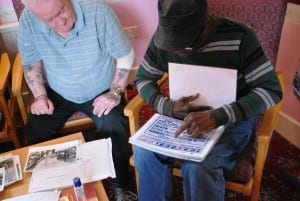Community Curation
By Betsy Lewis-Holmes, on 18 July 2013
Post by Chloe Chandler. Chloe has been volunteering for the project since January 2013 and is interested in the social meanings of objects.
One of the most striking and interesting aspects of Touching Heritage sessions is how museum objects stimulate personal memories. This personal impact encouraged Betsy and I put our heads together to think of a way of developing these ideas in order to explore the object/person relationship further. The idea of the ‘Community Curated Project’ was born. The idea was to seek out participants from various healthcare settings and encourage them to select and bring along an object of their own to share with a facilitator.
During our first community curated session, we were blown away by the amazing objects that participants had brought with them. The seven senior men and women who took part in this first session brought objects with them which ranged from family photos, medals from the Second World War, a selection of prints of photos sourced from local council archives, a nineteenth century seaman’s diary, and a painted walking cane a participant fashioned from the wood of a Ghanaian mangrove.
We encouraged participants to share their stories through asking questions, such as:
- Why have you brought this object in to show?
- How long have you owned it?
- Do you often share this object with others?
- What do you find interesting about this object?
- What does this object symbolise for you?
- Does this object bring back memories?
- Are there relationships associated with the object? (I.e. was the object a gift?)
Objects that initially seemed to be connected to generic public history were given a personal significance. Participants Paul and Lee both brought in prints of photos from their local archives. When I first saw these late nineteenth century/ early twentieth century photos of South-East London streets, I assumed that our session had been misunderstood. We didn’t want to hear about general London histories, we wanted to hear about personal memories.
However, as Paul and Lee began to talk about the images it became obvious that I was one who was mistaken. Generic black and white photos of street scenes with unknown individuals were transformed into a complex personal mental geography. Each photo of a ‘generic’ street scene had been specifically selected to remember, sustain, and re-create a sense of familial place in the City. Memories were mapped onto these photos. Once they realised their families had come from a similar area of the East End, Paul and Lee, who had never before met, were almost frantic in their exchange of stories via the matching up of archival photos of roads and local landmarks pictured in the images.
Speaking about these personal memories had transformed these public access archival prints into powerful artefacts of deep personal significance. In short they became the artefacts of a ‘personal museum.’
 Close
Close


